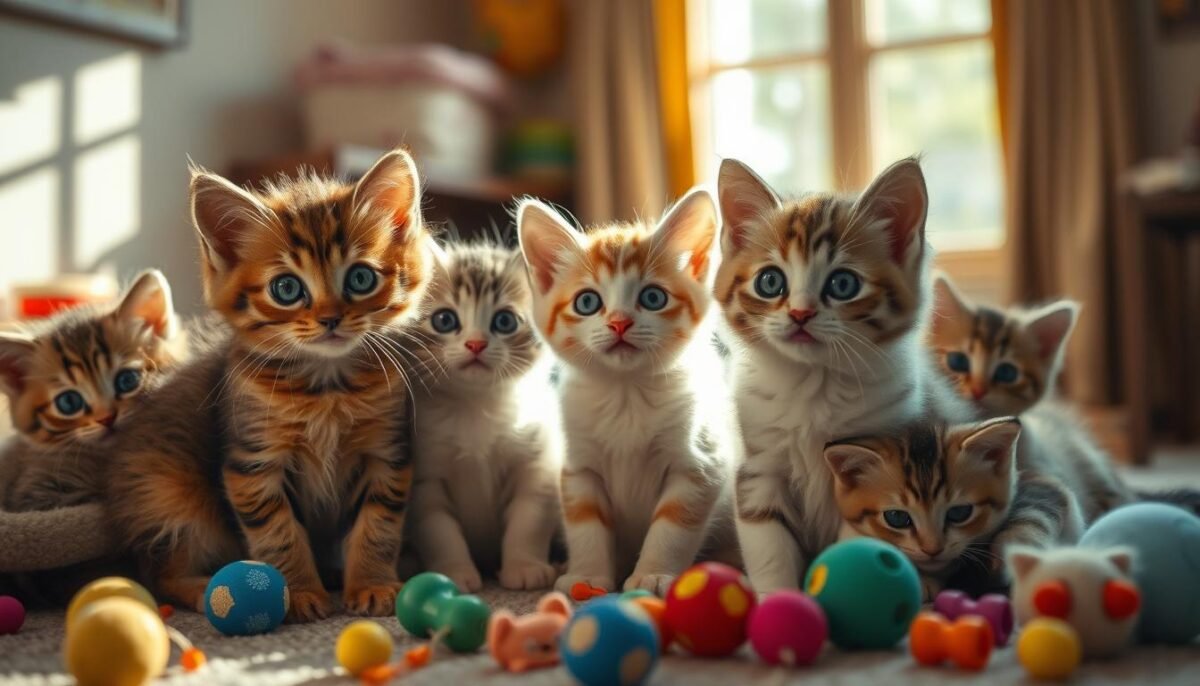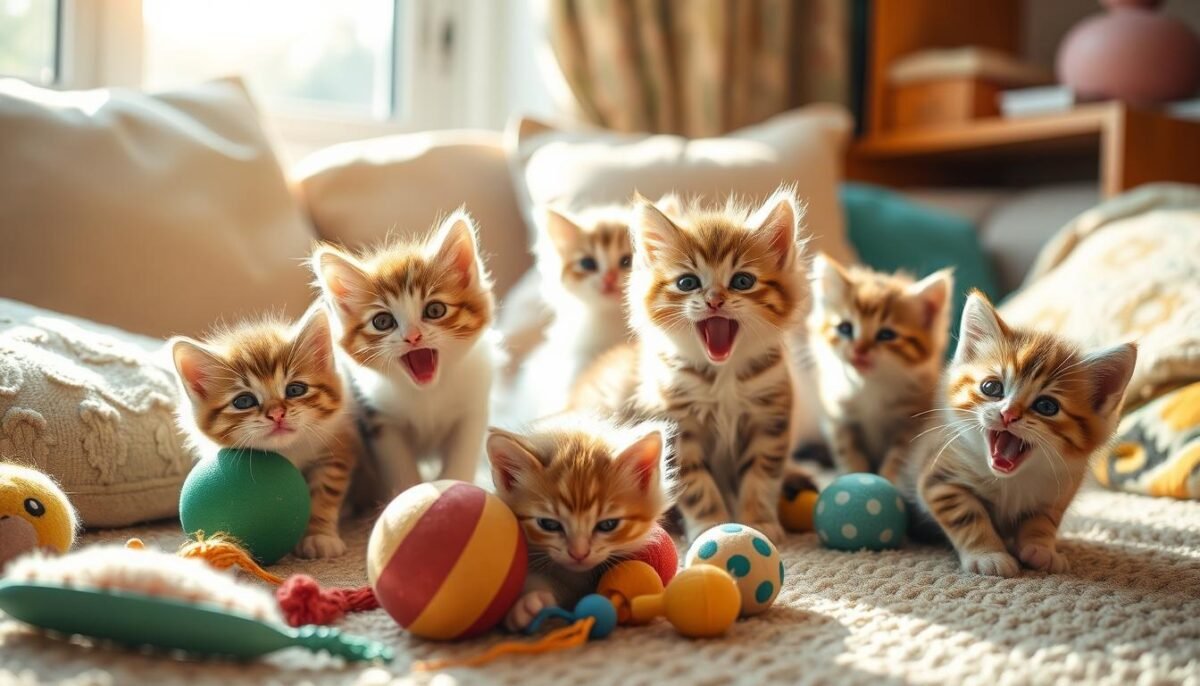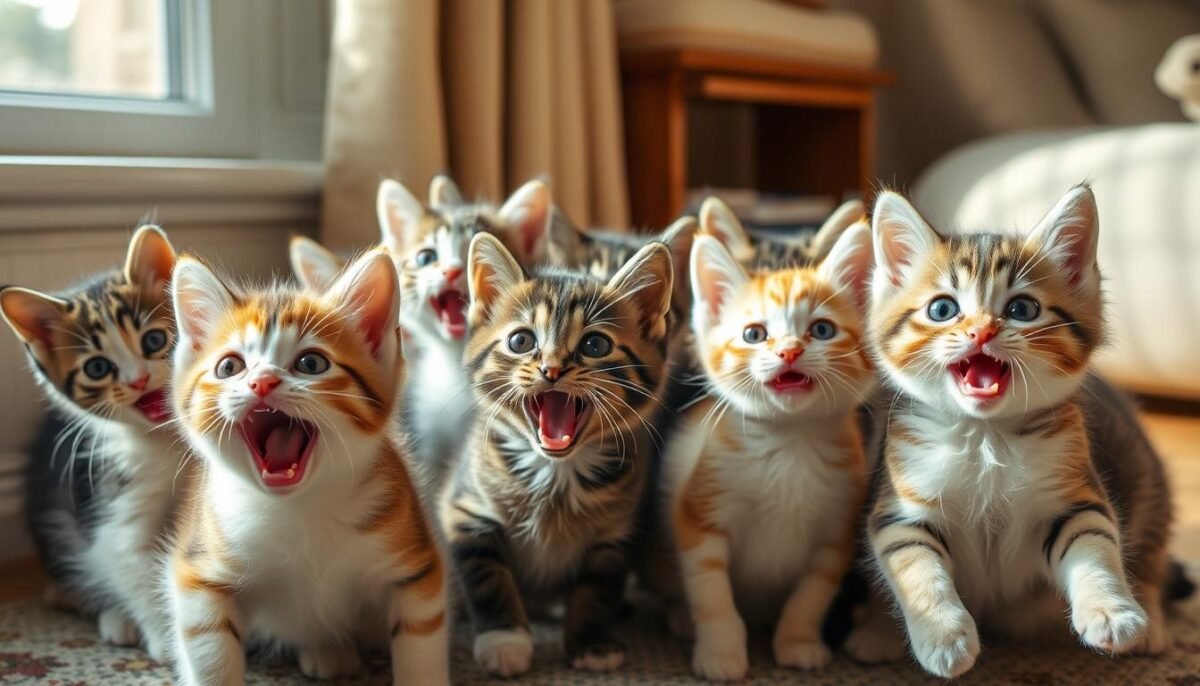As proud pet owners, we can’t help but be captivated by the adorable sounds our kittens make. From the gentle purrs to the excited meows, these sounds are more than just cute. They are a window into our feline friends’ thoughts and feelings.
By understanding the science behind kitten communication, we can forge a stronger bond. We can provide our furry companions with the care and attention they deserve.

Key Takeaways
- Kittens develop vocal communication skills from a young age, using different types of meows to convey their needs and emotions.
- Decoding the subtle nuances of kitten vocalizations can help owners better meet their pets’ needs and build a deeper connection.
- Understanding the science behind common kitten sounds, such as hunger cues and attention-seeking behaviors, allows owners to respond appropriately.
- Observing a kitten’s body language and establishing a communication routine can further strengthen the bond between cat and caretaker.
- Mastering the language of kittens meowing is a rewarding journey that enhances the joy of pet ownership.
Understanding the Basics of Kitten Communication
As your kitten starts to explore, their sounds are key to their growth and talking to others. From their first meows to many cat calls, knowing how kittens talk can help you understand them better.
The Development of Vocal Communication in Young Cats
Kittens start making sounds just a few days after they’re born. They use simple cries and whimpers to ask for help. As they get older, they learn to make more sounds like meows and purrs. This shows they’re learning about their world and how to talk to others.
Why Kittens Start Meowing
Kittens start meowing because they have new needs and want to talk to others. They meow when they’re hungry, uncomfortable, or want attention. This helps them tell others what they need and feel closer to them.
Different Types of Early Cat Vocalizations
- Meows: These sounds can mean many things, like happiness or sadness.
- Purrs: Kittens purr to show they’re happy and to calm themselves down.
- Chirps and Trills: These sounds are for when kittens are playful and curious.
- Yowls and Growls: Kittens use these loud sounds when they’re scared, angry, or defending their space.
Understanding kitten talk helps you connect with your pet better. Learning about their early sounds can open up a new world of understanding your kitten’s life.

The Science Behind Kittens Meowing: Vocal Patterns and Meanings
Kittens are known for their cute meows. But what do these sounds really mean? The science behind kitten meows is quite interesting.
Meowing is how cats talk, and kittens start early. They use their larynx to make different sounds. Kittens learn to change their meows to show hunger or playfulness.
Studies show kitten meows have special meanings. High-pitched meows mean they’re upset. Short, urgent meows mean they’re hungry or want attention. Knowing these kitten meows and cat sounds helps pet owners understand their pets better.
“Kittens use meowing as a primary means of communication, and their vocalizations can reveal a wealth of information about their needs and emotions.”
The science of kitten meowing shows how complex cat communication is. By understanding these kitten meows, we can meet our pets’ needs better.

| Vocal Pattern | Meaning |
|---|---|
| High-pitched, drawn-out meows | Distress or discomfort |
| Short, urgent meows | Hunger or desire for attention |
| Soft, conversational meows | Contentment or affection |
Common Reasons Why Your Kitten Won’t Stop Meowing
Kittens are adorable, and their kitten meows are a big part of that. But, when they meow too much, it might mean they need something. Knowing why your kitten meows a lot can help you meet their needs and bond with them.
Hunger and Feeding Time Signals
Kittens need to eat often because they have fast metabolisms. They might meow to tell you it’s time for food. Watch when your kitten meows and try to feed them at the same times every day.
Attention-Seeking Behaviors
Kittens love attention, and they meow to get it. If your kitten meows without reason, they might want to play or cuddle. Play with them, give them toys, and spend time together to meet their needs.
Signs of Discomfort or Illness
Too much meowing can also mean your kitten is uncomfortable or sick. They might meow if they’re in pain or stressed. If your kitten’s meowing changes with their behavior or looks, see a vet to check on them.
Understanding why your kitten meows can help you meet their needs. This can make your relationship with them stronger and more loving.
How to Interpret Different Types of Kitten Sounds
Understanding your kitten’s sounds is a fun journey into their world. From the meow to the purr, each sound tells you something special. It shows their needs, feelings, and actions.
Let’s look at the different sounds kittens make and what they might mean:
- Meows: Meows can be soft or loud. Kittens meow when they’re hungry, uncomfortable, or want attention.
- Purrs: A purr means your kitten is happy and comfortable. They might purr when being petted or cuddled.
- Trills: Trills are high-pitched chirps. Kittens use them to say hello or show excitement.
- Yowls: Yowls are long sounds that show frustration, anger, or a desire to mate (in older cats).
- Hisses and Growls: Kittens hiss or growl when they’re scared, angry, or uncomfortable. It’s a way to say they’re threatened.
Knowing the context and body language helps understand your kitten’s cat sounds and kitten communication. By listening to their kitten meows, you can strengthen your bond and meet their needs better.
| Kitten Sound | Potential Meaning |
|---|---|
| Meow | Hunger, discomfort, attention-seeking |
| Purr | Contentment, comfort, affection |
| Trill | Greeting, excitement |
| Yowl | Frustration, anger, mating (older cats) |
| Hiss/Growl | Fear, aggression, discomfort |
“The language of cats is the language of the heart.” – Sigmund Freud
Building a Stronger Bond Through Understanding Cat Calls
Learning your kitten’s way of talking is key to a closer bond. By understanding their cat calls and body language, you can create a strong connection. This connection is based on mutual understanding and respect.
Reading Your Kitten’s Body Language
Watch how your kitten stands, looks, and acts to understand their feelings. A calm, straight posture means they’re happy. But a hunched, tense body might show they’re scared or upset. Knowing these signs helps you understand their meowing better.
Responding Appropriately to Different Meows
Every kitten communication has its own message. A loud, persistent meow might mean they’re hungry. A soft, chirping sound usually means they love you. By recognizing and answering these sounds, you meet their needs and grow closer.
Creating a Communication Routine
Make a routine of talking to your kitten through play, grooming, or just sitting together. Set aside time each day for these activities. This lets your kitten know when to cat call and helps you respond in the right way.
FAQ
What are the common types of kitten vocalizations?
Kittens use different sounds to talk to us, like meows, purrs, and chirps. Each sound means something, like they’re hungry or happy to see you.
Why do kittens start meowing?
Kittens meow to tell us what they need or how they feel. It’s their way of saying they’re hungry, uncomfortable, or want some love.
How do I interpret the different meanings behind my kitten’s meows?
Kitten meows can mean many things, like they’re hungry or lonely. Listen to how they sound and what’s happening around them to understand what they’re saying.
What are some common reasons why my kitten won’t stop meowing?
Kittens meow a lot for reasons like being hungry, wanting attention, or feeling sick. Finding out why they’re meowing helps us meet their needs and stop the meowing.
How can I build a stronger bond with my kitten by understanding their communication?
Learning what your kitten’s meows and body language mean can make your bond stronger. By understanding them, you can talk to your kitten better and enjoy a closer relationship.





